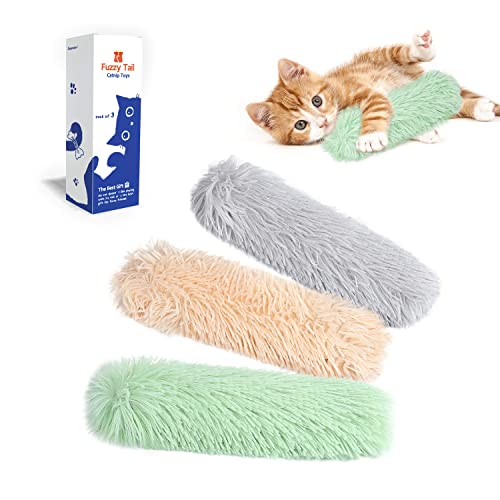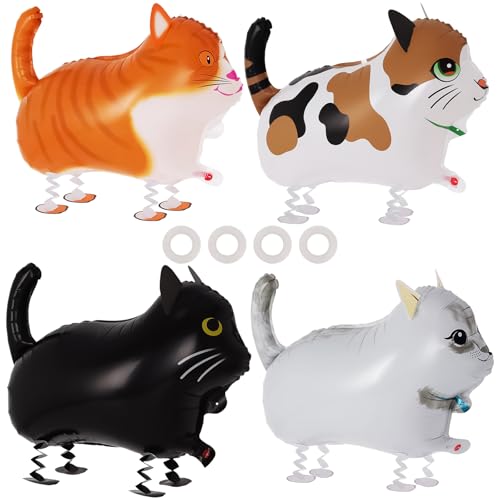Why Are Cats Afraid of Balloons?
As a cat lover, you may have noticed that your furry friend gets startled or frightened by balloons. But have you ever wondered why? Well, let’s dive into the fascinating world of feline behavior to understand why cats are often afraid of balloons.
1. Unpredictable movements: Cats are naturally curious creatures, but they like it when things stay predictable. Balloons, with their erratic movements caused by air currents or even a gentle touch, can confuse and startle your cat. This unpredictability triggers their survival instincts, making them feel threatened or unsafe.
2. Unusual shapes: Cats rely heavily on their vision to navigate the world around them. Balloons, with their unusual and exaggerated shapes, can appear strange and unfamiliar to your cat. This can disrupt their sense of normality and trigger a fear response.
3. Startling sounds: Balloons are known for making unexpected noises. The sudden pop or hiss of air escaping can startle your cat and create anxiety. Cats have sensitive hearing, and these loud and startling sounds can trigger a stress response.
4. Past negative experiences: Cats are creatures of habit, and if they’ve had a negative experience with balloons in the past, they may associate balloons with fear and anxiety. This can contribute to their fear response when encountering balloons again.
It’s important to remember that every cat is unique, and their reactions to balloons may vary. Some cats may be completely unfazed by balloons, while others might be extremely fearful. Understanding why cats are afraid of balloons can help you better support and comfort your feline friend. In the upcoming sections, we’ll explore some tips to help cats overcome their fear of balloons. Stay tuned!
Note: Do not include a concluding paragraph.
Instinctual Triggers for Cats
As a cat lover, you may find it puzzling why your fluffy friend is so afraid of balloons. Well, it all comes down to their instinctual triggers. Cats are creatures of habit and have developed strong survival instincts over thousands of years. So, let’s dive into some reasons why those bright, floating orbs make your cat’s fur stand on end.
Unpredictable Movements: Cats are inclined to be cautious around unfamiliar, moving objects. Balloons float, twist, and turn with the slightest breeze, making their movements difficult to predict. This unpredictability triggers your cat’s natural prey instincts, making them wary and on high alert.
Unusual Shapes: Balloons come in all sorts of shapes and sizes, and this can be confusing for your feline companion. Cats rely heavily on visual cues to understand their environment. When faced with a balloon, their brains may struggle to make sense of the strange shape, leading to fear and apprehension.
Startling Sounds: The squeaky sound of a balloon can be quite surprising for your kitty. Cats have hypersensitive hearing and are attuned to detecting even the slightest noise. When a balloon pops or squeaks, it startles your cat and triggers their fight-or-flight response.
Negative Experiences: It’s essential to consider your cat’s past experiences with balloons. If they’ve had a negative encounter, such as a loud balloon pop, they may associate balloons with danger and develop a fear response. Cats have long memories and can be deeply affected by traumatic events.
The Unpredictable Movements of Balloons
As a cat lover, you might have noticed that your furry friend becomes nervous or fearful around balloons. One of the reasons for this is the unpredictable movements of balloons.
Cats have incredible reflexes and are skilled hunters. They are naturally cautious around unfamiliar, moving objects as they analyze them for potential threats. Balloons can be quite unsettling for cats because they move in an erratic and unpredictable manner.
From a cat’s perspective, balloons can be perceived as a potential danger due to their sudden shifts in direction and unexpected bursts. These sudden movements trigger a cat’s instinct to stay alert and beware of potential predators.
Additionally, cats have a hard time making sense of unusual shapes, and balloons definitely fit the bill. Their elongated, floating shapes can appear strange and unfamiliar to your feline companion. They rely heavily on their sharp senses to navigate their surroundings and any visual disturbance can cause confusion and unease.
Moreover, the sound of a balloon popping or hissing as it deflates can startle even the bravest cats. Cats have highly sensitive hearing, which enables them to detect the faintest sounds. The sudden loud noise produced by a bursting balloon can be overwhelming and frightening for them.
It is also important to consider that negative past experiences with balloons can contribute to a cat’s fear response. Like humans, cats have memories and can associate certain objects or situations with negative experiences. If your cat has had a negative encounter with a balloon in the past, it is likely that they will be more fearful and avoidant of them in the future.
Understanding the unpredictable movements, unusual shapes, and startling sounds of balloons can help you empathize with your cat’s fear. By creating a safe environment for your feline companion and providing comfort and reassurance, you can help alleviate their anxiety and fear surrounding balloons.
The Unusual Shapes and Sounds of Balloons
Balloons can be quite unsettling for cats due to their unusual shapes and startling sounds. Let’s delve into why these factors can trigger fear and anxiety in our feline friends.
Unpredictable Movements: Cats are creatures of habit and thrive in a predictable environment. Balloons, on the other hand, are known for their erratic and unpredictable movements. They float, they sway, they bounce, which can be highly unsettling for your cat. These seemingly random movements can confuse and alarm them, making them feel threatened.
Confusing Shapes: Cats rely heavily on their keen sense of sight to navigate and make sense of their surroundings. The unusual shapes of balloons with their elongated bodies and vibrant colors can be quite perplexing for our feline companions. It’s like encountering an unknown and unfamiliar creature, which can cause confusion and anxiety.
Startling Sounds: The loud noises produced by balloons, especially when they burst, can startle cats and send them running for cover. Cats are known for their acute hearing, and sudden loud noises can trigger their fight-or-flight response, causing them to feel scared and on edge. This fear response can be further reinforced if they have had negative past experiences with balloons and their loud noises.
It’s important to note that not all cats are afraid of balloons, but for those who are, understanding the reasons behind their fears can help us better support and comfort them.
Helping Your Cat Overcome Their Fear
If you’ve noticed that your cat is afraid of balloons, it’s important to understand that their fear is real and it can cause them a great deal of stress. Fortunately, there are steps you can take to help your furry friend overcome their fear and feel more at ease. Here are a few tips to assist you in helping your cat navigate their fear of balloons:
- Create a Safe Space: Just like humans, cats crave a safe and secure environment. Designate a specific area in your home where your cat can retreat to when they’re feeling anxious. This could be a cozy corner or a separate room with their bed, toys, and litter box. Make sure this space is quiet and free from loud noises that might startle them.
- Gradual Exposure: Introduce your cat to balloons slowly and gradually. Start by placing deflated balloons in a controlled and calm environment. Allow your cat to investigate the balloons at their own pace. Make sure to provide positive reinforcement such as treats or gentle praise when your cat shows curiosity or courage.
- Desensitization: Help your cat become accustomed to the unusual sights and sounds of balloons by exposing them to inflated balloons from a distance. Begin by inflating a balloon in another room while your cat is in their safe space. Gradually decrease the distance between your cat and the balloon over time, monitoring their comfort level. Repeat this process, ensuring that your cat feels safe and secure throughout each session.
- Positive Associations: Associate balloons with positive experiences for your cat. Engage in playtime near balloons and reward your cat with their favorite treats or toys. By creating positive associations, you can help your cat develop a more positive mindset towards balloons.
- Seek Professional Help: If your cat’s fear of balloons persists or worsens, it may be beneficial to seek guidance from a professional animal behaviorist or veterinarian. They can provide expert advice tailored to your cat’s specific needs and help develop a personalized fear-reducing plan.
Remember, each cat is unique and may require different approaches to overcome their fear of balloons. Be patient, understanding, and supportive throughout the process. With time and consistent effort, you can help your cat feel more confident and comfortable in the presence of balloons.
Conclusion
Understanding why your cat is afraid of balloons can help you provide the necessary support and create a safe environment for them. Balloons can trigger a cat’s natural instincts due to their unpredictable movements, unusual shapes, and startling sounds. This can make them feel threatened and anxious.
To help alleviate your cat’s fear of balloons, consider creating a safe space where they can retreat to when they feel scared. Gradual exposure and desensitization techniques can also be effective in helping your cat become more comfortable around balloons. Additionally, using positive associations, such as offering treats or playtime near balloons, can help your cat develop a more positive outlook.
Remember, every cat is unique and may require different approaches to overcome their fear of balloons. If your cat’s fear persists or worsens, it may be beneficial to seek professional help from a veterinarian or animal behaviorist.
By understanding your cat’s fear and implementing appropriate strategies, you can help your furry friend feel more at ease and ensure a happy and stress-free environment for both of you.
Frequently Asked Questions
Q: Why are cats afraid of balloons?
A: Cats are often afraid of balloons due to their unpredictable movements, unusual shapes, and startling sounds. These factors can trigger a cat’s natural instincts and make them feel threatened.
Q: How can I help alleviate my cat’s fear of balloons?
A: There are a few ways you can help your cat overcome their fear of balloons. Creating a safe space for them, gradually exposing them to balloons, and using desensitization techniques can be effective. Additionally, associating balloons with positive experiences and seeking professional help if needed can also aid in reducing your cat’s anxiety surrounding balloons.
Q: Are all cats afraid of balloons?
A: No, not all cats are afraid of balloons. Each cat is unique and may have different fears or triggers. Some cats may not be bothered by balloons at all, while others may display fear or anxiety. It’s important to understand and respect your cat’s individual temperament and provide any necessary support if they do exhibit fear towards balloons.













